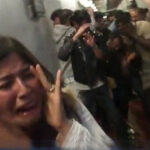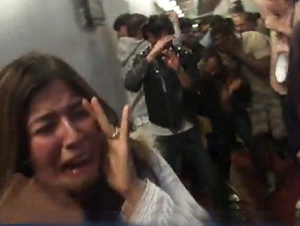
SMC — A long-awaited report released Friday afternoon analyzing a protest at Santa Monica College over a controversial two-tier tuition scheme found that students, police and administrators shared blame in events that led to dozens of people being exposed to pepper spray outside an April Board of Trustees meeting.
The report found there was inadequate planning in advance of the event, poor crowd control on the part of Santa Monica College Police Department, inadequate communication equipment, "unacceptable" conduct on the part of protesters and inappropriate force used by one member of campus police.
It also provides a list of 13 recommendations that prescribe better communication and planning as well as specific policies regarding the use of pepper spray and police batons.
Campus officials will begin putting those recommendations in place immediately, with a progress report in 60 days, said SMC President Chui Tsang.
"I concur with the Review Panel's observation that this is incompatible with our shared values," Tsang said. "By adopting these recommendations, Santa Monica College will strengthen its commitment to values of mutual respect and collegial communication."
On April 3, protesters rallied in front of a Board of Trustees meeting in protest of a two-tier policy that would have allowed students to pay the full cost of some classes offered in the summer as a means to provide more seats. Demand for certain courses has outgrown the supply, denying students the chance to progress towards graduation.
According to the report, protesters tried to force their way into the meeting rather than watch it from an "overflow" room. Campus police were overwhelmed and one released pepper spray in the cramped hallway.
Dozens were exposed and at least two people were taken to the hospital. A 4-year-old child was among those affected.
In the face of public outcry, Tsang appointed a panel to review materials related to the incident to assess what could have been done differently rather than assign blame or punish.
The panel, comprised of SMC officials, Trustee Nancy Greenstein and student Joshua Scuteri, amongst others, analyzed video evidence, police reports, anonymous survey responses and other materials documenting the incident.
They also reviewed police guidelines and campus policies regarding crowd management to see where officials erred in dealing with the situation.
The result was a 184-page document that gives a blow-by-blow account of the night and leaves no group involved unscathed.
Leading up to the event, campus police were unprepared despite watching campus protests related to the two-tier system develop through "intelligence gathering" through conversations with students, information revealed publicly on the Internet and public statements made by protesters.
An investigating officer told officials that the police expected a disruption at the meeting, but created no plan for entry or exit from the meeting nor dealing with the mass of people who showed up.
According to the report, police were actually "too trusting" of students. Of the two operations plans developed for the meeting, neither included the possibility of an unruly protest, and only six officers were on duty.
While the report faults police for not controlling crowds around the door, it singled out Sgt. Jeremiah Williams for inciting protesters by forcibly closing the door to the meeting room and then using inappropriate force against them.
Police had control of the door when Williams chose to close it. He physically redirected one student back toward the crowd, knocked another protester to the ground and ultimately released pepper spray in the confined hallway with little warning.
That contravened policy directing the use of pepper spray in several ways. Williams also used his own canister of spray that had a concentration over six times the strength of that issued by the campus police.
Williams resigned from SMC in October.
The report does not shy away from putting blame at the door of the protesters, saying that "at least a minority of their number intended to use disruptive tactics rather than reasoned arguments."
It specifically calls out the former president of the Associated Students for instructing protesters to keep the boardroom door open and says he intended to "incite others to use force rather than reason."
Furthermore, the report says that students involved didn't know enough about their rights to exercise them appropriately, and that faculty and other officials didn't help — no one informed them that their actions violated campus policies and, in fact, a Faculty Association bullhorn was used by students.
The report concluded with a set of 13 recommendations that emphasized planning before "large protest events" and better communication between police, students, faculty and administrators.
The recommendations included better training for police officers in incident planning and a revision and clarification of policies regarding crowd control, the use of batons and explicit guidelines regarding the strength and composition of pepper spray.
They also suggest buying sound equipment so that students can hear police officers' directions.
Managers involved are to look at the recommendations, evaluate what's in place and forward the results to Tsang to put in place a plan that will accomplish the recommendations, said Don Girard, senior director of governmental relations and institutional communications at SMC.
No additional funding will be made available for various departments to put the recommendations in place, Girard said.
For a copy of the full report, visit http://www2.smc.edu/review_panel_report/.
ashley@www.smdp.com








